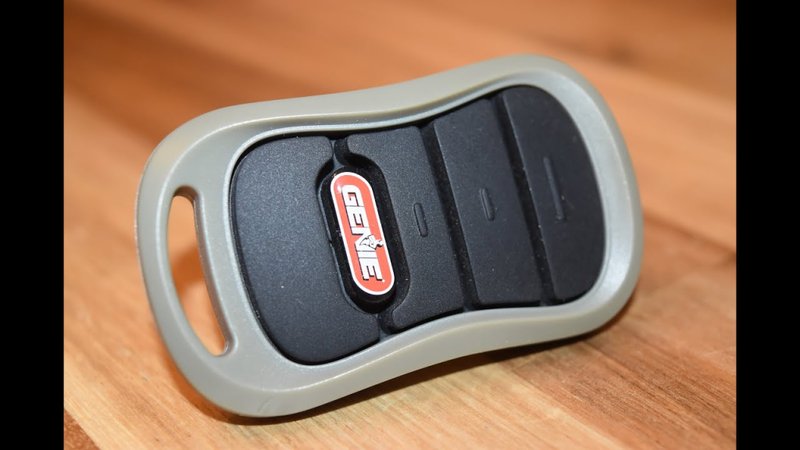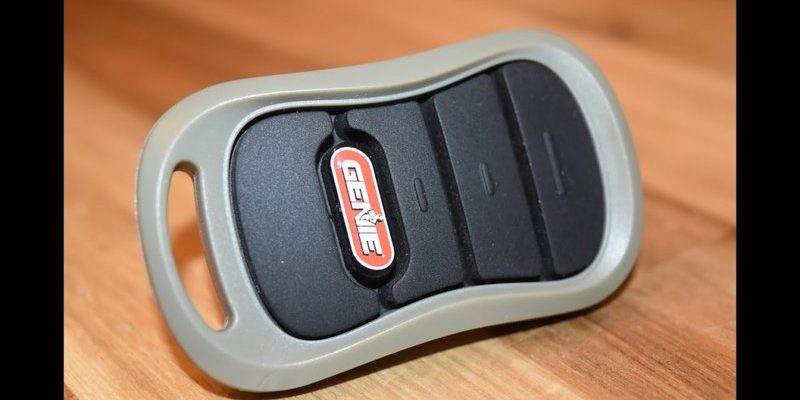
A garage door opener sounds simple—press a button, door moves. But inside that little remote is a surprisingly clever bit of tech. Genie, one of the big names in garage door openers, uses rolling codes and syncing processes to keep your garage secure. So when the remote stops working or refuses to pair with the opener, it can feel like you’re locked out of your own tech. The good news? Most syncing problems have straightforward causes, and you don’t need an engineering degree to sort them out.
How Genie Garage Remotes Communicate With Openers
Let me explain what’s going on behind the scenes when you press that button. Your Genie garage remote sends a unique signal to the opener—think of it like a secret handshake. This isn’t a simple “on/off” switch. Instead, Genie uses rolling code technology, which means each time you press the remote, it generates a different code. This prevents random devices from accidentally opening your garage.
The remote and opener must speak the same “language.” During setup, you pair (or sync) the remote with the opener by pressing a “Learn” or “Program” button on the opener itself. When things are working, it’s seamless. But if the codes fall out of sync, if you’ve replaced the battery, or if you’re using a universal (instead of Genie-branded) remote, you can run into trouble.
Honestly, the system is secure but a bit picky. Even small hiccups—like weak batteries or radio interference—can mess up the signal. So, if your Genie remote isn’t syncing, it’s usually a sign that either the communication got interrupted or the two devices just aren’t on the same page anymore.
Common Reasons Your Genie Garage Remote Won’t Sync
You might be wondering, “Is it broken? Did I mess something up?” Before tossing your remote in frustration, let’s walk through the usual suspects:
- Dead or low battery: Sometimes it’s the simplest thing. If your Genie remote isn’t lighting up or works sporadically, the battery might be on its last leg. Replacing it, even if you just did recently, is step one.
- Incorrect syncing sequence: Each Genie model has a specific way to enter programming mode. If you miss a step—or hold the button for too long or not long enough—the remote won’t sync.
- Radio interference: Wireless routers, LED lights, even your neighbor’s gadgets can interfere with the signal. If you’ve got lots of new electronics or moved the opener, this could be your culprit.
- Using a non-Genie remote: Universal remotes are convenient, but not every model is compatible out of the box. Sometimes extra steps are needed, or in a few cases, it just won’t work at all.
- Malfunctioning opener or remote: Of course, there’s always a chance the internal parts have failed. Genie remotes are tough, but nothing lasts forever—especially with heavy daily use.
Often, it’s a mix of small things adding up. Double-check each step, and you’ll probably discover the root of your syncing woes.
Step-By-Step: How to Resync Your Genie Garage Remote
Here’s the thing: syncing a garage remote isn’t rocket science, but it’s easy to mix up steps, especially if you’re flustered. Here’s how to pair your Genie remote with the opener, no tech jargon:
- Locate the “Learn” or “Program” button on your Genie opener (usually under the light cover or on the back panel).
- Press and release the “Learn” button. You’ll see an LED light start blinking—this means the opener is listening for a remote signal.
- Quickly grab your Genie remote and press the main button (the one you use for the garage) once, firmly. The blinking LED should turn solid, then go off—signaling successful pairing.
- Test the remote. If the door doesn’t move, repeat the process, making sure not to hold the button too long or too short. Timing can make a difference.
Pro tip: Some Genie remotes have multiple buttons for multiple doors. Make sure you’re pressing the correct button during code pairing.
If you’re using a universal remote, check the manufacturer’s instructions—sometimes you’ll need to enter a Genie-specific code or go through a slightly different syncing process.
When to Reset Your Genie Opener and Remote
If syncing hasn’t worked, it might be time for a reset. Think of this like giving your devices a blank slate to try again.
Most Genie openers have a reset feature. To wipe the opener’s memory:
- Hold the “Learn” or “Program” button until the LED turns off (usually about 10 seconds).
- This erases all paired remotes, so you’ll need to reprogram each one from scratch.
- Now, follow the pairing process from the previous section for each remote you own.
This reset is like clearing out old, mismatched codes that could be causing confusion. If you’ve bought a house and don’t know what remotes are connected—or if the opener seems “full”—resetting gets everything back to square one.
Important: Only reset if you’re sure, as this wipes all remote pairings, including keypads or car-integrated remotes.
Signs Your Genie Remote Needs Replacing
Sometimes, no amount of troubleshooting solves the problem because the remote itself is faulty. Remotes get dropped, corroded, or just plain old. Here’s how to tell if it’s time for a new one:
- No LED response: After a fresh battery, the indicator light stays dark when you press buttons.
- Inconsistent performance: It works sometimes, but not always—even after re-syncing and resetting.
- Physical damage: Sticky buttons, visible cracks, or corrosion inside the battery compartment are red flags.
- Other remotes work, but not this one: If you have multiple Genie remotes and only one fails, it’s probably just that specific remote.
Don’t forget: a compatible replacement doesn’t have to be the newest fancy model. As long as it’s made for your Genie opener series, it’ll do the job.
Genie Branded Remotes vs. Universal Remotes: What to Know
Let’s clear up some confusion here. Genie brand remotes are designed for, well, Genie openers. They’re usually the easiest to sync—follow the manual’s process and you’re done. Universal remotes, on the other hand, try to work with many brands. That’s great for flexibility, but sometimes means extra programming steps or even incompatibility.
If you’re considering a universal: Check the packaging for a compatibility list. Some Genie openers use new rolling code security that older universal remotes can’t handle. Even if it “sort of works,” you might find limited range, spotty connection, or the need to re-sync often.
A quick tale: I once tried a universal remote from the hardware store with my parent’s classic Genie opener. It worked—half the time. Turns out, it was missing the right “learn code” sequence for that model, and every time there was a power outage, I had to repeat the process. Sometimes, sticking with the Genie brand saves headaches.
Understanding Genie Remote Codes and Interference
Here’s where things can get a bit technical—but stick with me. Genie remotes use security codes that change every time you press the button, making it nearly impossible for someone to “clone” your remote signal. This technology, called “Intellicode” by Genie, is great for security but can be finicky when interference is present.
Interference: Wireless devices, cordless phones, even some newer light bulbs can block or scramble the signal. If your syncing issues happen only in certain spots—or the remote works up close but not from the driveway—try unplugging or moving electronics near your opener. Sometimes just changing the angle you use the remote can make a difference.
If you have lots of remotes, keypads, or smart devices connected to your Genie opener, be patient: the opener has to keep up with each synced device and sometimes needs a reset to clear out “old” codes.
Other Troubleshooting Tips for Stubborn Genie Remotes
If you’ve tried syncing, resetting, changing batteries, and still nothing—don’t give up yet. Some extra things to check:
- Check for obstructions: Metal cabinets, thick walls, or parked vehicles can block the signal. Try standing closer, or move any large metal objects out of the path.
- Verify model compatibility: Not every Genie remote works with every Genie opener, especially across generations or with newly purchased units. The model number is usually printed inside the battery compartment.
- Test the opener itself: Press the wall control or physical button. If the opener doesn’t respond, the problem could be with the opener, not the remote.
Final insight: Sometimes it’s not about the remote at all, but a power issue, a tripped sensor, or a wiring glitch on the opener. If multiple remotes, keypads, or car-integrated buttons fail at the same time, the issue is almost certainly at the opener end—not the remote.
When to Call For Professional Help
There’s a point where DIY fixes just won’t cut it. If you’ve methodically tried re-syncing, replacing batteries, resetting the opener, and checking for obvious damage—and the Genie remote still refuses to play nice—it could mean:
- The opener’s internal circuit board is faulty.
- There’s deep electrical interference in your garage.
- The system needs a firmware update or replacement.
If you’re out of ideas and patience, scheduling a service call is just practical. Trained technicians can pinpoint issues with diagnostic tools and sometimes spot what a casual checkup misses. Plus, it keeps you from getting locked out—or worse, locked in.
When in doubt, trust your instincts. If something feels off, unusual, or just won’t respond, it’s better to get help than risk a security issue or wiring hazard.
Bringing It All Together: Getting Your Genie Remote Back on Track
A Genie garage remote that won’t sync is frustrating, but rarely unsolvable. Take it step by step: check batteries, follow the pairing process, scan for interference, and don’t be afraid to reset or try another remote. Most syncing headaches trace back to simple miscommunications between device and opener, and a little patience usually wins out.
Think of your remote as a handshake, not a magic spell. Sometimes it just needs a second try—or a little troubleshooting nudge—to work smoothly. Stick to the basics, and your garage door will open like clockwork again. If not, there’s no shame in calling in a pro for backup. After all, your time is better spent enjoying your day—not stuck in the driveway arguing with your gadgets.
